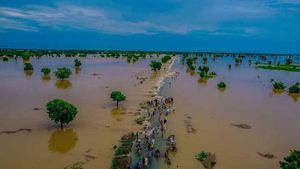A La Niña watch remains active as we head deepeningly toward the peak of hurricane season, with meteorologists now anticipating favorable odds for its emergence. By this fall, the odds stand at about 66 percent, as forecasters watch developments across the eastern Pacific Ocean where cooler than normal sea temperatures are expected to bring substantial weather changes.
La Niña is not just one of those weather terms tossed around casually; it significantly shapes global weather patterns. It’s characterized by sea surface temperatures being at least 0.5°C lower than average for over seven consecutive months. This notable cooling manifests itself through varied weather impacts worldwide—from drier conditions leading to droughts, to heightened hurricane activity across the Atlantic.
Presently, sea surface temperatures around the equator are hovering around their long-term averages, with the situation classified as ENSO-neutral (which stands for El Niño Southern Oscillation). This balance indicates neither La Niña nor El Niño conditions are predominant. But this balance could tip soon, with NOAA predicting La Niña could establish itself by the fall. They noted, "There’s more than enough indication for the emergence of this weather pattern, potentially disrupting the Atlantic hurricane season."
When La Niña conditions are present, reduced wind shear becomes commonplace which, as researchers explain, can be quite beneficial for storm formation. Wind shear involves how winds blow at different altitudes, and when it is reduced, tropical disturbances can consolidate and grow more easily. This means not only does the potential for creating tropical systems increase, but existing weather disturbances have the chance to strengthen significantly. NOAA experts are already calling for the 2024 Atlantic hurricane season to be exceptionally active, predicting enough named storms to almost stretch the official list of storm names.
The past months have already witnessed four named storms—Hurricane Beryl, which quickly intensified to become the earliest Category 5 hurricane seen, and Hurricane Debby, which made landfall as a Category 1 storm flooding parts of the Eastern U.S. “The Atlantic hurricane basin is expected to be remarkably active due to several factors,” NOAA noted, highlighting warm sea surface temperatures, the effects of La Niña, and African monsoon activity as major contributors to the expected surge of storms.
Experts stress the importance of keeping very close tabs on emerging weather systems. A budding storm system currently stirring near the Lesser and Greater Antilles, has been observed by NOAA with roughly 80 percent likelihood of developing over the coming week. Its path—moving west-northwestward—is likely to put it within range of the U.S. coast by mid-next week. If this system fully develops, it will be named Ernesto, and with conditions as they are, it’s presumed to garner strength as it approaches land.
Given the advancing hurricane season, it’s easy to see why this anticipation surrounds the potential evolution of La Niña. Since the season runs from June 1 to November 30, with its height typically occurring around the second week of September, it’s critical to remain alert. The ramifications of this weather pattern sway far and wide, instigated by the shifts it prompts not only within the atmospheric phenomena but the resulting immediate and long-term meteorological conditions.
Even beyond hurricane activity, La Niña can have far-reaching consequences for winter weather patterns across North America. For example, places like the Southern U.S. might see warmer and dryer conditions, aggravation of drought situations, and increased susceptibility to wildfires. Conversely, areas like the Northern Plains can expect colder temperatures along with frequent winter storms, which could exacerbate heating demands. Given these diverse and severe impacts, regional responses may need to adapt significantly to ward off the trouble brought on by nature's playing ground.
The northern regions, including the Pacific Northwest, are anticipated to see wetter winters, contributing positively to rain and snowpack—which is beneficial for local agriculture and water resources. On the flip side, the southern parts will grapple with arid conditions likely to challenge water availability. The ripple effects of these phenomena affirm the delicate balance of our climatic systems and underlie the significance of keeping informed as the transition to La Niña takes shape.
Climate scientists continue to eye the cooler-cooling Pacific Ocean, watching closely for how the transition influences the establishment of La Niña, which, if it pops up sooner rather than later, could lead to pronounced changes to everyday weather patterns across the globe. Not just summer storms, but the looming winter season will also be considerably impacted, making it imperative for all to stay updated on the latest forecasts as these developments emerge.
The anticipation of La Niña’s arrival shouldn’t merely be observed through the lens of marine conditions alone, but rather should also serve as an important reminder of our interconnected world, where atmospheric shifts can ripple across vast distances, bringing direct consequences to life as we know it. Understanding these changes allows communities, governments, and individuals alike to prepare and adapt effectively, ensuring safety and resilience against nature’s whims and moods. Delaying the proactive measures until after the fact, as evidenced by past hurricane seasons, is no longer viable; the narrative of preparation must become the rule, rather than the exception.



